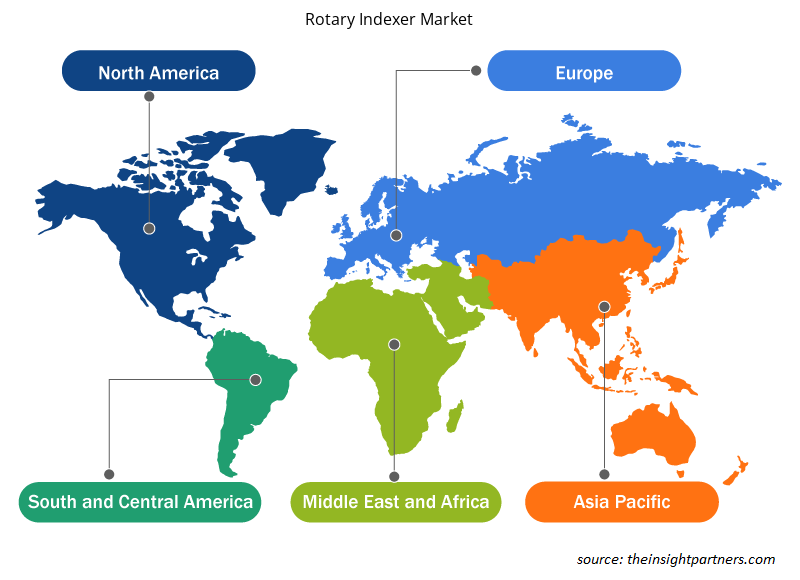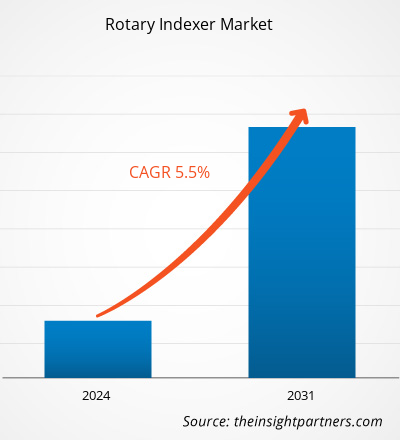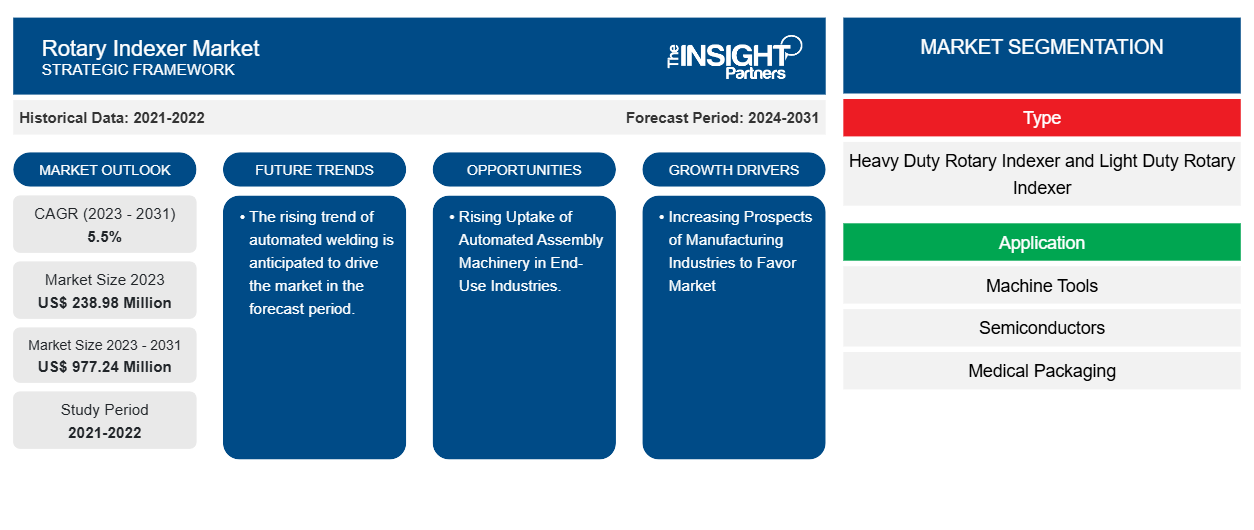Si prevede che la dimensione del mercato degli indicizzatori rotanti raggiungerà i 977,24 milioni di dollari entro il 2031, rispetto ai 238,98 milioni di dollari del 2023. Si prevede che il mercato registrerà un CAGR del 5,5% nel periodo 2023-2031. Le crescenti prospettive nelle industrie manifatturiere e i vantaggi degli indicizzatori rotanti di precisione rispetto agli indicizzatori rotanti convenzionali saranno probabilmente i principali driver e tendenze del mercato.
Analisi di mercato dell'indicizzatore rotativo
Il mercato degli indicizzatori rotanti sta vivendo una crescita significativa a livello globale. La crescita è attribuita a fattori quali le crescenti prospettive nelle industrie manifatturiere e i vantaggi degli indicizzatori rotanti di precisione rispetto agli indicizzatori rotanti convenzionali. Inoltre, si prevede che la crescente adozione di macchinari di assemblaggio automatizzati nelle industrie di utilizzo finale e la tendenza crescente della saldatura automatizzata offriranno diverse opportunità per il mercato nei prossimi anni.
Panoramica del mercato degli indicizzatori rotanti
Il sistema di indicizzazione rotativa è un meccanismo sofisticato e altamente efficiente utilizzato in vari settori per semplificare i processi di produzione. Questa tecnologia di automazione consente il movimento e il posizionamento precisi dei pezzi in lavorazione a intervalli predeterminati, consentendo alle postazioni di lavoro di assemblaggio di eseguire attività specifiche con eccezionale accuratezza.
Personalizza questo report in base alle tue esigenze
Riceverai la personalizzazione gratuita di qualsiasi report, comprese parti di questo report, o analisi a livello nazionale, pacchetto dati Excel, oltre a usufruire di grandi offerte e sconti per start-up e università
-
Scopri le principali tendenze di mercato in questo rapporto.Questo campione GRATUITO includerà analisi di dati che spaziano dalle tendenze di mercato alle stime e alle previsioni.
Driver e opportunità del mercato degli indicizzatori rotanti
Prospettive crescenti delle industrie manifatturiere per favorire il mercato
Il settore manifatturiero, come l'apprendimento automatico, la robotica e l'intelligenza artificiale, ha permesso alle macchine di eguagliare o superare gli esseri umani in una serie di attività, tra cui le attività cognitive richieste a vari livelli di produzione. La produttività migliorata varia tra il 10% e il 20% quando l'automazione viene implementata su qualsiasi linea di montaggio snella. Inoltre, l'Industria 4.0 è un'altra tendenza in voga che si prevede invaderà il settore manifatturiero nei prossimi anni. La crescente adozione di indicizzatori rotanti ha portato a livelli crescenti di automazione nel settore manifatturiero in tutto il mondo.
Crescente diffusione di macchinari di assemblaggio automatizzati nei settori di utilizzo finale.
Un sistema di assemblaggio automatizzato è costruito con l'aiuto di dispositivi meccanizzati e automatizzati che eseguono tutti diversi processi nella costruzione di un singolo articolo/prodotto. I sistemi meccanici sono in genere concepiti per eseguire movimenti ripetitivi fissi, come le sequenze fisse necessarie per l'assemblaggio di parti e prodotti. Inoltre, ci sono vari attori sul mercato che offrono macchinari di assemblaggio automatizzati. Aziende come Grob, HIRATA, ATS Automation Tooling Systems, NITTO SEIKO, Tach Precision Engineering, Teamtechnik (Dürr), Juki, Tateyama Auto Machine, Autec Mechanical e molte altre.Grob, HIRATA, ATS Automation Tooling Systems, NITTO SEIKO, Tach Precision Engineering, Teamtechnik (Dürr), Juki, Tateyama Auto Machine, Autec Mechanical, and many more.
Analisi della segmentazione del rapporto di mercato dell'indicizzatore rotativo
I segmenti chiave che hanno contribuito alla derivazione dell'analisi di mercato degli indicizzatori rotanti sono tipologia, applicazione e settore di utilizzo finale.
- In base al tipo, il mercato degli indicizzatori rotanti è suddiviso in indicizzatori rotanti per impieghi gravosi e indicizzatori rotanti per impieghi leggeri. Si prevede che il segmento degli indicizzatori rotanti per impieghi gravosi detenga una quota di mercato significativa nel periodo di previsione.
- In base all'applicazione, il mercato degli indicizzatori rotanti è suddiviso in macchine utensili, semiconduttori, imballaggi medicali, saldatura automatizzata, robotica e sistemi di taglio di assemblaggio. Si prevede che il segmento delle macchine utensili detenga una quota di mercato significativa nel periodo di previsione.
- In base al settore di utilizzo finale, il mercato è segmentato in automotive, medicale e sanitario, elettronica, trasporti e aerospaziale. Si prevede che l'automotive detenga una quota di mercato significativa nel periodo di previsione.
Analisi della quota di mercato degli indicizzatori rotanti per area geografica
L'ambito geografico del rapporto di mercato sugli indicizzatori rotanti è suddiviso principalmente in cinque regioni: Nord America, Asia Pacifico, Europa, Medio Oriente e Africa, e Sud e Centro America.
Il Nord America ha dominato il mercato degli indicizzatori rotanti. Le tendenze di adozione di tecnologie elevate in vari settori della regione nordamericana hanno alimentato la crescita del mercato degli indicizzatori rotanti. Fattori quali l'adozione crescente di strumenti digitali e l'elevata spesa tecnologica da parte delle agenzie governative, le crescenti prospettive nelle industrie manifatturiere e i vantaggi degli indicizzatori rotanti di precisione rispetto agli indicizzatori rotanti convenzionali dovrebbero guidare la crescita del mercato degli indicizzatori rotanti nordamericani. Inoltre, una forte enfasi sulla ricerca e sviluppo nelle economie sviluppate degli Stati Uniti e del Canada sta costringendo gli operatori nordamericani a portare sul mercato soluzioni tecnologicamente avanzate. Inoltre, gli Stati Uniti hanno molti operatori del mercato degli indicizzatori rotanti che si sono sempre più concentrati sullo sviluppo di soluzioni innovative. Tutti questi fattori contribuiscono alla crescita del mercato degli indicizzatori rotanti nella regione.
Approfondimenti regionali sul mercato degli indicizzatori rotanti
Le tendenze regionali e i fattori che influenzano il mercato degli indicizzatori rotanti durante il periodo di previsione sono stati ampiamente spiegati dagli analisti di Insight Partners. Questa sezione discute anche i segmenti e la geografia del mercato degli indicizzatori rotanti in Nord America, Europa, Asia Pacifico, Medio Oriente e Africa, e America centrale e meridionale.

- Ottieni i dati specifici regionali per il mercato degli indicizzatori rotanti
Ambito del rapporto di mercato dell'indicizzatore rotativo
| Attributo del report | Dettagli |
|---|---|
| Dimensioni del mercato nel 2023 | 238,98 milioni di dollari USA |
| Dimensioni del mercato entro il 2031 | 977,24 milioni di dollari USA |
| CAGR globale (2023-2031) | 5,5% |
| Dati storici | 2021-2022 |
| Periodo di previsione | 2024-2031 |
| Segmenti coperti |
Per tipo
|
| Regioni e Paesi coperti |
America del Nord
|
| Leader di mercato e profili aziendali chiave |
|
Densità dei player del mercato degli indicizzatori rotanti: comprendere il suo impatto sulle dinamiche aziendali
Il mercato del Rotary Indexer Market sta crescendo rapidamente, spinto dalla crescente domanda degli utenti finali dovuta a fattori quali l'evoluzione delle preferenze dei consumatori, i progressi tecnologici e una maggiore consapevolezza dei vantaggi del prodotto. Con l'aumento della domanda, le aziende stanno ampliando le loro offerte, innovando per soddisfare le esigenze dei consumatori e capitalizzando sulle tendenze emergenti, il che alimenta ulteriormente la crescita del mercato.
La densità degli operatori di mercato si riferisce alla distribuzione di aziende o società che operano in un particolare mercato o settore. Indica quanti concorrenti (operatori di mercato) sono presenti in un dato spazio di mercato in relazione alle sue dimensioni o al valore di mercato totale.
Le principali aziende che operano nel mercato degli indicizzatori rotanti sono:
- Colombo Filippetti Sp. A
- Società Nabtesco
- FIBRO India
- Automazione Haas, Inc.
- COSTRUZIONE MACCHINE GMBH
- Gruppo Goizper
Disclaimer : le aziende elencate sopra non sono classificate secondo un ordine particolare.

- Ottieni una panoramica dei principali attori del mercato degli indicizzatori rotanti
Notizie di mercato e sviluppi recenti degli indicizzatori rotanti
Il mercato degli indicizzatori rotanti viene valutato raccogliendo dati qualitativi e quantitativi dopo la ricerca primaria e secondaria, che include importanti pubblicazioni aziendali, dati associativi e database. Di seguito sono elencati alcuni degli sviluppi nel mercato degli indicizzatori rotanti:
- DETRON ha collaborato con PMC e KTR per collaborare allo sviluppo di un nuovo dispositivo denominato "Machine Tool Rotary Table Drive Efficiency Testing Device". Questa tecnologia, sviluppata in collaborazione con il Precision Machinery Research and Development Center (PMC) e DETRON e che integra la tecnologia di rilevamento della coppia MONITEX-BT di KTR, segna il primo dispositivo specializzato del settore per la misurazione dell'efficienza degli azionamenti delle tavole rotanti. (Fonte: sito Web aziendale DETRON, marzo 2024)
Copertura e risultati del rapporto di mercato dell'indicizzatore rotativo
Il rapporto "Dimensioni e previsioni del mercato degli indicizzatori rotativi (2021-2031)" fornisce un'analisi dettagliata del mercato che copre le seguenti aree:
- Dimensioni e previsioni del mercato degli indicizzatori rotanti a livello globale, regionale e nazionale per tutti i principali segmenti di mercato trattati nell'ambito dell'indagine.
- Tendenze del mercato degli indicizzatori rotanti e dinamiche di mercato, quali fattori trainanti, limitazioni e opportunità chiave.
- Analisi dettagliata delle cinque forze PEST/Porter e SWOT.
- Analisi di mercato degli indicizzatori rotanti che copre le principali tendenze del mercato, il quadro globale e regionale, i principali attori, le normative e i recenti sviluppi del mercato.
- Analisi del panorama industriale e della concorrenza che comprende la concentrazione del mercato, l'analisi della mappa di calore, i principali attori e gli sviluppi recenti nel mercato degli indicizzatori rotanti.
- Profili aziendali dettagliati.
- Analisi storica (2 anni), anno base, previsione (7 anni) con CAGR
- Analisi PEST e SWOT
- Valore/volume delle dimensioni del mercato - Globale, Regionale, Nazionale
- Industria e panorama competitivo
- Set di dati Excel
Report recenti
Testimonianze
Motivo dell'acquisto
- Processo decisionale informato
- Comprensione delle dinamiche di mercato
- Analisi competitiva
- Analisi dei clienti
- Previsioni di mercato
- Mitigazione del rischio
- Pianificazione strategica
- Giustificazione degli investimenti
- Identificazione dei mercati emergenti
- Miglioramento delle strategie di marketing
- Aumento dell'efficienza operativa
- Allineamento alle tendenze normative























 Ottieni un campione gratuito per - Mercato degli indicizzatori rotanti
Ottieni un campione gratuito per - Mercato degli indicizzatori rotanti